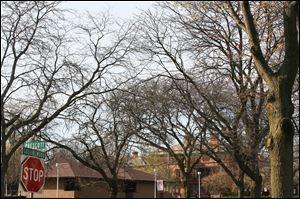
OLD WEST END
Residents start online petition to save trees
Removal scheduled on Collingwood Blvd.
5/21/2012
The trees, mostly honey locusts, are to be removed and replaced along part of Collingwood Boulevard. City officials say excavation for a drainage-improvement project this year will inflict serious damage on the trees’ roots.
Old West End residents unhappy with Toledo’s plans to remove — and later replace — trees along part of Collingwood Boulevard that is scheduled for reconstruction next year are conducting an online petition drive they hope to use to persuade the city to change its mind.
The online petition, based on the SignOn.org Web site with the title “Preserving our Old West End Historic District Landscape” and drafted by Scottwood Avenue resident David Neuendorff, argues that city officials have failed to comply with the National Historic Preservation Act of 1966 because they did not involve neighborhood residents throughout the project’s planning and did not notify them of rights the federal law affords them.
Mr. Neuendorff contends that recent traffic counts on Collingwood fall far short of the numbers presented in the project plans, and thus maintaining two lanes of traffic in both directions is no longer justified.
Rebuilt with just two lanes, the street would be narrow enough to save the 72 curbside trees, mostly honey locusts, that the city says must be cut down next year because project-related drainage improvements will destroy significant parts of their root networks.
“We support the idea of reducing the width of Collingwood Avenue [sic] in order to return Collingwood Avenue to a more residential street. A street more in character with the other main ‘wood’ streets in the Old West End Historic District,” Mr. Neuendorff wrote in the petition.
“In order to preserve the historic landscape of our neighborhood we want the large canopy trees preserved, which is possible if Collingwood is narrowed and returned to an earlier epoch with a wider tree lawn.”
But David Dysard, planning administrator at the city division of engineering services, said that even if the Collingwood were to be narrowed to two lanes with parking only on one side, excavation for drainage improvements would inflict serious root damage to the trees, and the drainage work itself will deprive the trees of subsurface moisture.
“I don’t know what we could do differently to save those trees,” said Mr. Dysard, who lives in the Old West End.
Collingwood is to be rebuilt next year between Monroe Street and Central Avenue after a water-main replacement project set for this year. The trees probably will be cut down next spring, when the street reconstruction is set to begin, Mr. Dysard has said.
City officials plan to keep four lanes south of Islington Avenue because buses and delivery trucks often make stops in front of schools, churches, and businesses, Mr. Dysard said. Changing the right lanes in either direction to parking would allow only a 4-foot reduction in Collingwood’s width, the city planner said, and even eliminating one lane would save only 9 more feet — not enough, he said, to avoid tree roots that sprawl as far underground as the trees’ branches do above the street.
On the more residential section north of Islington, the street will be changed to two travel lanes plus parking on either side and a median or left-turn lane in the center. But north of Islington, Collingwood has few curbside trees. The construction plan calls for sidewalks between Winthrop and Monroe streets to be shifted to the curb, so that there will be space on the off-street side to plant trees within the public right of way. Planting farther from the pavement’s edge will reduce damage to the trees when the street needs another rebuilding decades from now, Mr. Dysard said.
But the petition opposes moving the sidewalks.
“We disagree that there are no ‘adverse effects’ to the residential fabric of the Old West End Historic District by cutting down mature trees, moving sidewalks, forever changing our cultural landscape and appearance,” Mr. Neuendorff wrote. “Reconstructing Collingwood Avenue for traffic volumes that will never again exist, since the construction of expressways carrying car and truck traffic around this historic Toledo neighborhood, is not respectful to our historic heritage.”
As of Sunday night, the petition had received 263 digital signatures, most from Toledo and neighboring communities, but some from as far away as California and Hawaii.
“I lived in Toledo for 5 years and the only place I would consider living is in the Old West End,” wrote Alan Evans, of Conde, Tenn. “I took my daily walk, walked my dog, and always enjoyed the canopy of big old trees. The Old West End is a jewel not to be tampered with.”
Mr. Neuendorff said he has no schedule for presenting the petition to the city, Ohio Department of Transportation, and Federal Highway Administration. “Since the project does not have to start until spring of 2013, and so many individuals are signing up daily, we will wait a while before we present our petition,” he said. He added that critics have submitted comments as part of the historic-district review process being conducted by the city and ODOT.
The department, which administers the federal funds for Ohio projects, said last month that it considers the city to be in compliance with the federal regulations pertaining to the historic-district review.
Contact David Patch at: dpatch@theblade.com or 419-724-6094.